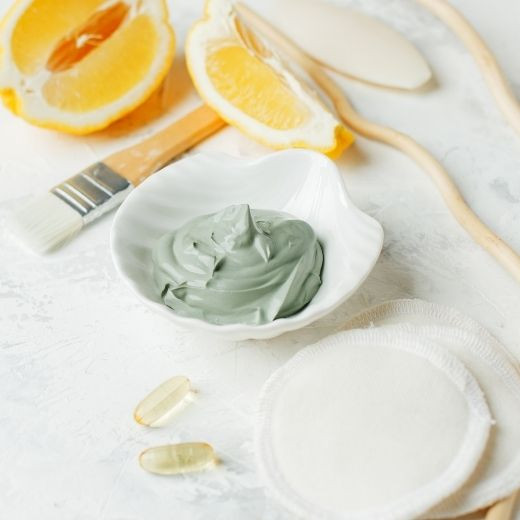The Best Ingredients for Fighting Acne
Posted by Ellie Swain on Apr 28th 2022
Most of us have battled acne at some point in our lifetime, whether it’s been the few odd breakouts or deep, angry cysts. In fact, acne affects around 50 million Americans each year .
Acne can be stubborn and persistent, making a huge impact on your mental wellbeing.
Fortunately, plenty of treatments, including over-the-counter formulas, prescription products, and dermatological procedures, can help clear your skin.
But with so many anti-acne products on the market, it can be challenging to choose one and know which is best for you.
That’s where we come in to help. Here are the best ingredients for battling the dreaded acne, most of which you can purchase in over-the-counter products.
Benzoyl peroxide
Benzoyl peroxide is an over-the-counter topical treatment that reduces the amount of acne-causing bacteria that lives on the skin. By killing acne-causing bacteria, the ingredient can lessen the number of whiteheads and larger pimples lurking under the skin.
It can also reduce the frequency of breakouts.
Salicylic acid
Salicylic acid is a much-loved acne-fighting skincare ingredient. Many over-the-counter and prescription skincare products for breakout-prone skin contain the ingredient.
It’s a beta hydroxy acid, meaning it’s an exfoliant and removes dead skin. This helps unclog your pores.
Use salicylic acid as a cleanser, gel, moisturizer, or cream. Nowadays, there are plenty of options featuring the ingredient. Use salicylic acid once or twice daily, depending on the product you’re using.
While choosing a higher concentration of salicylic acid may be tempting, this doesn’t mean it will be more effective. In fact, if you’re new to salicylic acid, opting for a high concentration can aggravate and redden your skin, which certainly isn’t what you want.
You’ll likely see concentrations ranging from around 0.5 to 5 percent. A good target use is 1 to 2 percent. After all, you can always increase the concentration if your skin can handle it.
We love PCA Skin’s acnegel. The salicylic acid acne treatment treats existing blemishes and prevents future breakouts. The botanical blend controls oil production throughout the day and is suitable as a full-face formula for oily or combination skin or as a spot treatment for the odd breakout on all skin types.
Charcoal
Charcoal is a potent cleansing agent that binds to and absorbs impurities to remove them from the skin. The ingredient is particularly good at removing oil, so it works excellently in removing pore-clogging sebum.
However, charcoal can be drying. If this is a concern, keep an eye out for white charcoal, which is much softer and gentler.
Charcoal works particularly well in a face mask, and we’re a fan of the Cosmedix Detox Activated Charcoal Mask . The product functions like a magnet, drawing out pore-clogging dirt, oils, and impurities while cleaning away age-accelerating pollutants.
The skin is left clearer, fresher, and more clarified.
Lactic acid
Lactic acid is an alpha hydroxy acid (AHA). This is a chemical exfoliant that removes dead skin cells from the upper layers of the skin.
Some anti-acne ingredients like benzoyl peroxide and salicylic acid may be too harsh if you have sensitive skin. In this case, seek products containing lactic acid.
The ingredient is gentler and is well-suited to sensitive skin.
Retinol
Retinol is famed as an anti-aging ingredient, but it also works wonders for treating acne.
The powerful ingredient stimulates cell turnover in the lower layers of skin, helping to prevent pores from becoming blocked with dead skin and sebum.
Retinol is usually available in gel form. As retinol is so potent, start small and go slow when first using the ingredient. Start with low concentrations and don’t apply the ingredient every day.
Retinoids can cause symptoms like redness, dryness, itching, and sun sensitivity in the early days. It’s best to start using it by applying it every other night or every third night to reduce side effects. Then you can eventually increase the frequency to every day once your skin gets used it.
Tea tree
Tea tree is renowned for its anti-inflammatory and antiseptic properties. It can help calm and soothe existing breakouts, especially those scary, inflamed, red pustules.
The ingredient can also help trigger white blood cells, accelerating the healing process.
While tea tree oil is an effective acne treatment, it may not work as fast as other ingredients.
Zinc
Zinc acts as both an anti-inflammatory and an anti-bacterial, helping calm even the most aggravated breakouts.
The ingredient is best suited to treat papules and cystic blemishes rather than blackheads and whiteheads.
Do you want more skincare advice? Here’s how to switch to a more sustainable skincare routine .

